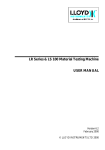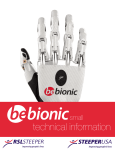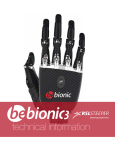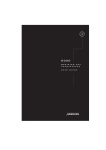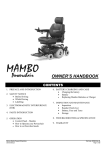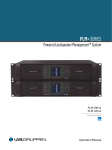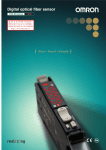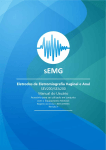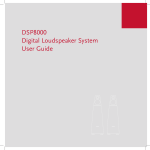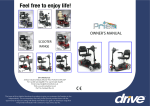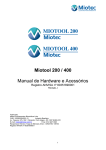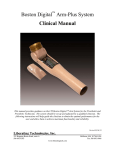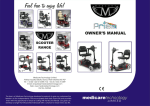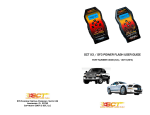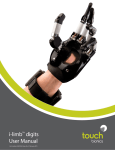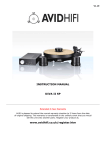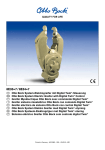Download View/Open - DukeSpace
Transcript
From "MEC 11 Raising the Standard," Proceedings of the 2011 MyoElectric Controls/Powered Prosthetics Symposium Fredericton, New Brunswick, Canada: August 14-19, 2011. Copyright University of New Brunswick. COMPARISON OF TWO MYOELECTRIC MULTI-ARTICULATING PROSTHETIC HANDS Brian Waryck, CP/L Advanced Arm Dynamics, Inc., 123 West Torrance Blvd., Suite 203, Redondo Beach, CA 90277 INTRODUCTION Myoelectric prosthetic hands with powered multiarticulating fingers offer users the promise of increased functional grasp options, previously unavailable in a myoelectric prosthetic hand. We take a comparison look at two multi-articulating myoelectric prosthetic hand systems, the bebionic v2 from RSLSteeper and the i-LIMB Pulse from Touch Bionics, Inc. These myoelectric prosthetic hands are categorically the same design, given that each hand has five multi-articulating powered fingers, including a thumb that can also be passively positioned in an opposed or non-opposed manner. By taking a closer look at each system, it is apparent that there are some unique features that differentiate these prosthetic hands. This comparison will focus on discussing the prosthetic hand features including available grip patterns, functional programming, graphic user interface, component compatibility, available load testing/grip force summary, battery options, glove options and sizing. In conclusion, the participant reader will have a better overall understanding of these systems and be better prepared to make a component decision regarding the desired clinical outcome for their clients. AVAILABLE GRIP PATTERNS With individual motors for all five fingers, each hand has the ability to achieve four selected, pre-programmed grip patterns. Table 1 shows the available pre-programmed grip patterns for each hand. The i-LIMB Pulse has 10 available pre-programmed grip patterns to choose from while the bebionic v2 has 11 available pre-programmed grip patterns. The 3 Jaw Chuck grip pattern provides prehension when the thumb, index and middle fingers close together. The i-LIMB Pulse flexes the 3rd and 4th fingers fully closed to remain out of the way, while the bebionic v2 is designed so the 3rd and 4th fingers move with the thumb, index and middle fingers. Power grip provides prehension with the bebionic v2 by closing the index, middle, 3rd and 4th fingers onto an object followed by the thumb closing down over the dorsum of the index and middle fingers to secure the grip. With the i-LIMB Pulse, power grasp is not pre-programmed, but can be achieved by using a manual stall technique with the thumb. Once the fingers have made contact with an object, the opposed thumb is allowed to flex close to secure the grip pattern. Table 1: Available Hand/Grip Positions Hand/Grip Positions Multi-Articulating Hands i-Limb Pulse Bebionic v2 3 Jaw Chuck (1) (1) Power Grip * (2) Hook grip * ** Lateral/key grip (2) (3) Index Point (3) (4) Natural Hand (4) (5)*** Standard precision pinch open (5) n/a Thumb precision pinch open (6) (6)**** Standard precision pinch closed (7) n/a Thumb precision pinch closed (8) (7)***** Thumb park continuous (9) n/a Thumb park quick (10) n/a Pinch Grip n/a (8) Trigger Grip n/a (9) Column Grip n/a (10) Mouse Grip n/a (11) Finger Adduction n/a ****** Open Palm ******* ******* *achieved using a manual stall of thumb during flexion **achieved in power grip at the start of thumb flexion ***called relaxed hand position ****called precision open grip *****called precision closed grip ******non programmed grip pattern, achieved between index and middle fingers or middle and 3 rd fingers as they flex closed, best in power grip, key grip and 3 jaw chuck Distributed under a Creative Commons Attribution-Noncommercial-No Derivative Works 3.0 United States License by UNB and the Institute of Biomedical Engineering, through a partnership with Duke University and the Open Prosthetics Project. From "MEC 11 Raising the Standard," Proceedings of the 2011 MyoElectric Controls/Powered Prosthetics Symposium Fredericton, New Brunswick, Canada: August 14-19, 2011. Copyright University of New Brunswick. *******non programmed grip pattern, achieved with hand fully opened with thumb non-opposed The Lateral/Key grip moves the index, middle, 3rd and 4th fingers to a partially closed(bebionic v2) or fully closed(iLIMB) position, at which time the thumb can be opened/closed against the index finger. Index point is a grip pattern where the middle, 3rd and 4th fingers are flexed closed with the non opposed thumb closed against a fully extended index finger. The i-LIMB “Natural Hand” is a grip pattern which moves and holds the fingers in a slightly flexed, anatomically neutral position. This grip pattern is achieved with the bebionic v2 by accessing the Relaxed Hand Position grip pattern. Standard Precision Pinch Open(i-LIMB) allows the index and thumb to open/close while the middle, 3rd and 4th fingers remain positioned fully extended. Thumb Precision Pinch Open(i-LIMB) or Precision Open Grip(bebionic v2) allows the index to close against a partially flexed, parked thumb, while the middle, 3rd and 4th fingers remain positioned fully extended. Standard Precision Pinch Closed(i-LIMB) allows the index and thumb to open/close while the middle, 3rd and 4th fingers remain positioned fully flexed. Thumb Precision Pinch Closed(i-LIMB) or Precision Closed Grip(bebionic v2) allows the index to close against a partially flexed, parked thumb while the middle, 3rd and 4th fingers remain positioned fully flexed. Thumb Park Continuous(i-LIMB) moves all the digits to full extension and the thumb can be flexed or extended by the input signals. Thumb Park Quick(i-LIMB) moves all the digits to full extension and the thumb can be operated by the input signal for a time period of 1.5 seconds at which time the hand operation automatically returns to normal function for all digits. Pinch Grip(bebionic v2) is described as the opposed thumb closing to meet the closing index finger, while the other fingers close until they meet resistance or until the close signal stops. Trigger Grip(bebionic v2) is when the middle, 3rd and 4th fingers close securely onto a handle object followed by the opposed thumb flexing closed to secure the grip. The index finger can then close on the trigger of the device or open to a fully extended position before the other fingers will release their grip. Column Grip(bebionic v2) is when the non-opposed thumb flexes into the palm, followed by the flexing index, middle, 3rd and 4th fingers to form a fixed column point with the PIP aspect of the index and middle fingers. Mouse Grip(bebionic v2) flexes the nonopposed thumb and 4th finger to secure the sides of a computer mouse and uses the middle and 3rd fingers to provide additional stability. The index finger closes with a close signal and opens with an open signal to complete the mouse click cycle. ACCESSING GRIP PATTERNS The i-Limb Pulse can be programmed to utilize 4 grip patterns using 4 different input signals from the user. These input signals are described as hold open, double impulse, triple impulse and co-contraction. Each of these inputs can be programmed or linked to one of the 10 available preprogrammed grip patterns by using the BioSim Graphic User Interface (GUI). The i-LIMB Pulse is unaware of the thumb position relative to selected grip pattern. This means that the user must coordinate the non-opposed or opposed thumb position with the selected grip pattern. The user must also select the degree of thumb rotation desired from opposed to non-opposed endpoint positions. The bebionic v2 hand can be programmed to utilize 8 pre-programmed grip patterns total. These include 2 in primary opposed thumb position, 2 in secondary opposed thumb position, 2 in primary non-opposed thumb position and 2 in secondary non-opposed thumb position. The bebionic v2 hand accesses the grip patterns using input signals that are first dependent on one of the two definitive thumb positions, opposed or non-opposed. When the thumb is situated in the opposed position, 3 Jaw Chuck may be programmed as the default grip pattern with a switching input causing the hand to select a secondary grip pattern, power grasp, for example. When the thumb is in the nonopposed position, Key Grip may be programmed as the default grip pattern with a switching input causing the hand to select the secondary grip pattern, index point, for example. Regardless of current grip pattern, every time the thumb is shifted to the other toggled position, the default grip pattern for that thumb position, opposed or nonopposed, is automatically selected. Switching grip patterns within the current thumb position is achieved in the following manner. The hand must first be fully opened and then within 1 second following full extension, the user must provide either an (open) impulse or a co-contraction to select the alternative grip pattern for that thumb position. With the bebionic v2 hand switched ON, selecting the primary grip patterns or the secondary grip pattern options can be achieved by pressing the program switch for less than 2 seconds. The switch can be accompanied by an audible sound and a vibration if activated on bebalance. With The bebionic v2 hand switched OFF, the user can enter glove donning mode by pressing and holding the on/off membrane switch for 4 seconds until the hand automatically moves into the glove donning position. To exit glove donning mode, the user must press and hold the membrane switch for 4 seconds until the hand moves out of glove donning mode and into the default grip pattern selected. Distributed under a Creative Commons Attribution-Noncommercial-No Derivative Works 3.0 United States License by UNB and the Institute of Biomedical Engineering, through a partnership with Duke University and the Open Prosthetics Project. From "MEC 11 Raising the Standard," Proceedings of the 2011 MyoElectric Controls/Powered Prosthetics Symposium Fredericton, New Brunswick, Canada: August 14-19, 2011. Copyright University of New Brunswick. GRAPHIC USER INTERFACE (GUI) The i-LIMB Pulse hand utilizes the BioSim Basic or BioSim Professional software as the GUI. The hand communicates to the GUI via a USB BlueTooth enabled connector. This allows the prosthetist the ability to analyze the patients myoelectric signals, configure the myoelectric control strategy and view or change current input triggers for selected grip patterns. In BioSim Basic, thresholds are preset, while BioSim Professional allows the prosthetist the ability to change thresholds and customize power to motors for possible “new” automatic grip patterns. BioSim also gives battery status and uses serial number recognition for desired hand connection. The i-LIMB Pulse also has an available USB BlueTooth connector called BioSim Patient. This tool allows the patient the ability to view their myoelectric input signals and change their input trigger/output grip pattern setup at any time. The bebionic v2 hand utilizes the bebalance software as the GUI. The hand communicates to the GUI via an RF module/USB dongle connection. The hand, which houses the RF module, creates a unique connection with the GUI which allows the prosthetist the ability to view and change the setup for the hand while the system is being used by the patient. With the bebalance software open and the hand switched ON, the user simply holds the ON/OFF membrane switch depressed for more than 4 seconds to enable the RF module. The USB dongle blue light is solid, then a quick release of the ON/OFF switch completes the connection of the bebionic v2 hand to bebalance GUI. The bebalance GUI allows the prosthetist the ability to chose 1 of the 5 different operating modes, view myoelectric input signals, set and/or change ON and MAXIMUM thresholds, change default grip and second grip within allowed configuration options and as a training tool for working with the patient. COMPONENT COMPATIBILITY The following table creates a list of components that have been approved for compatible use by both Touch Bionics, Inc or RSLSteeper. Seeing this in one table opens up opportunities for multiple design configurations, as well as possible plug and play options with a patients existing myoelectric prosthesis. Please refer to Table 2 for specifics regarding component compatibility for each multiarticulating hand system. Table 2: Component Compatibility Component Multi-Articulating Hands i-Limb Pulse Bebionic v2 ?,yes,? yes, yes, yes yes,yes,yes,yes ?,?,?,? Otto Bock Inputs: 9X50, 9X51, 9X52 yes,yes,? yes,?,yes LTI Inputs: DC200B=50 yes yes LTI Inputs: TP01, LT01, LT02 ?,yes,yes yes,?,? Motion Control Inputs: yes, yes ?,? RSL Steeper Inputs: SEA200 yes yes Otto Bock Elbow: 12K44= yes yes Otto Bock Elbow: 12K50= yes yes Otto Bock Inputs: 13E125, 13E200, 13E202 Otto Bock Inputs: 9X14, 9X18, 9X25, 9X37 3010546, 3010292 LTI Elbow: BE330 ? yes Motion Control U3, U3+ yes yes Otto Bock Wrist Rotator and Myorotronic yes yes LOAD TESTING/GRIP FORCE SUMMARY A unique feature to the i-LIMB Pulse is the ability to add additional grip force to the object held by the hand. Table 3, in the following i-LIMB Pulse column, displays both the initial pinch force value and the “pulse” pinch force value. It is interesting to observe the differences between each hand regarding the load testing/grip force summary as listed in Table 3. Some of the parameters are very close to each other while others, like the overall load limits for each hand differ greatly. Some of these measurements may speak to the durability of each hand system as well as when it may or may not be clinically indicated to fit one of hand over the other. Each manufacturer makes a cautionary statement that their hand is designed and recommended for mild to moderate activities. They are not recommended for heavy duty usage or for exposure to wet environments. The glove options provide adequate protection for most normal situations, however extra precautions should be made not to expose the fingers/motors to water or a wet environment. Distributed under a Creative Commons Attribution-Noncommercial-No Derivative Works 3.0 United States License by UNB and the Institute of Biomedical Engineering, through a partnership with Duke University and the Open Prosthetics Project. From "MEC 11 Raising the Standard," Proceedings of the 2011 MyoElectric Controls/Powered Prosthetics Symposium Fredericton, New Brunswick, Canada: August 14-19, 2011. Copyright University of New Brunswick. Table 3: Load Testing/Grip Force Summary Specified Load/Grip Force Parameters Multi-Articulating Hands i-Limb Pulse bebionic v2 Lateral pinch force 4.62lb/*7.71lb 3.37lb restricted Index to thumb pinch force 2.75lb/*4.63lb 7.64lb Power grip 22.48lb/*30.64lb 16.86lb Load limits per digit 70.55lb 32.27lb Load limits overall 198.42lb 70.55lb Push up from w/c, hand closed 183lb 198.42lb Push up from w/c, single digit 28.5lb 13.23lb Carry heavy bag, full hand 231lb, no fail ? Carry heavy bag, one digit 103lb, no fail ? Carry heavy bag, thumb 79lb ? Weight, small / medium hand 1.014lb 1.18lb Weight, regular / large hand 1.025lb 1.19lb *with pulsing BATTERY OPTIONS The i-LIMB Pulse has two recommended internal battery options to choose from for best performance. The 2400 mAh capacity battery has a charge time of 6-7 hours while the 1300mAh battery has a charge time of 3 hours. The bebionic v2 hand also has two recommended internal battery options to optimize performance. The Single Battery(BBI=2200) has a 2200mAh capacity which takes 3.5hrs to fully charge from a depleted state. The Split Cell Battery(BBI=1300) has a 1300mAh capacity which only takes 2 hrs to fully charge from a depleted state. Both systems, RSLSteeper and Touch Bionics, Inc. recommend charging the battery every night, regardless of usage. When considering the installation of a wrist rotator the recommendation should lean toward use of the 2200mAh(RSLSteeper)or 2400mAh(Touch Bionics, Inc.) battery options. These battery options also help support consistent communication (blue tooth or RF module/USB dongle) with the hand during programming. third option for covering, which is a Custom High Definition Covering. This option provides the patient the most realistic match to the contralateral hand and arm size, shape and coloring details. The i-LIMB Pulse is available in two specified sizing options, Regular and Small. The bebionic v2 hand currently has one covering option available for each hand size. This covering system, the bebionic glove, is a variable hardness multilayered glove, mesh lined, available in 20 colors, fitted with custom made silicone factory fitted nails and integral silicone thimbles at the digit tips for additional grip compliance. The bebionic v2 hand is available in two sizes, Large and Medium. DISCUSSION We have taken an objective viewpoint from our experiences to date. Each hand represents an advancement in functional positioning for the user. As new multiarticulating hands enter the market, it will become increasingly important for the clinical team to understand the capabilities of each hand. This comparison creates an up to date way of seeing the prosthetic hand features including available grip patterns, functional programming, graphic user interface, component compatibility, available load testing/grip force summary, battery options, glove options and sizing. REFERENCES [1] [2] [3] [4] Touch Bionics, Inc., Service and fitting manual, part#137020A, issue #1.1 Jan 2011; Biosim manual, part#137022A, issue #1.1 Jan 2011; User manual, part#137021A, issue #1.1 Jan 2011 Touch Bionics, Inc., www.touchbionics.com RSLSteeper, “Bebionic hand and bebalance programming software technical manual, 2RSLLIT275, Issue 1 SteeperUSA, www.steeperusa.com GLOVE OPTIONS AND SIZING The i-LIMB Pulse has 3 covering options which can be utilized to match the patient needs. The i-LIMB skin offers a minimalistic covering approach which matches the mechanical contours and details of the hand, available in 4 color options and 2 hand sizes. The i-LIMB High Definition Covering offers the patient a more cosmetically appealing and durable cover, available in 10 color options, male or female and 2 hand sizes. The i-LIMB Pulse has a Distributed under a Creative Commons Attribution-Noncommercial-No Derivative Works 3.0 United States License by UNB and the Institute of Biomedical Engineering, through a partnership with Duke University and the Open Prosthetics Project.




